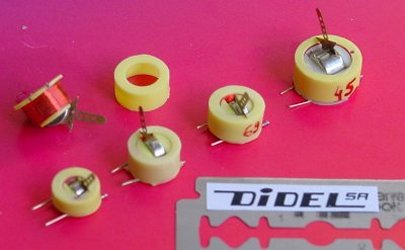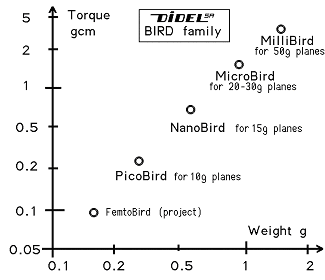Slow flyers |
|
BIRDS: Pico- Nano- Micro- Milli-
|
|
A BIRD (from Built In Rudder Device) is a magnetic
actuator that is light enough to be directly mounted on the rudder
itself and becomes part of the hinge of the rudder, or can be linked
to it with a short lever.
|
 |
 |
DIDEL announces its new family of magnetic actuators, for 7 to 50 grams planes. See Birds.doc for more information and FAQ.
 |
 |
| Name |
Weight grams
|
Size dia x height mm
(without arm) |
Coil res.
Ohms |
Torque
gcm |
Arm length
mm |
Price
|
| PicoBird |
0.33
|
6.2 x 3.6
|
70
|
0.35
|
2.5, 3.5, 4.5
|
63CHF, ca 42 USD
|
| NanoBird |
0.62
|
7.8 x 5
|
62
|
0.9
|
4, 5, 6
|
57 CHF, ca 38 USD
|
| MicroBird |
0.90
|
8.8 x 5
|
52
|
1.9
|
5, 6, 7, 8
|
48 CHF, ca 32 USD
|
| MilliBird |
1.5
|
10.4 x 5.5
|
40
|
3.6
|
5, 6, 7, 8
|
45 CHF, ca 30 USC
|
The torque of a magnetic actuator is proportional to the magnetic field of the NdFeB magnet (proportional to its mass), and to the magnetic field of the coil (proportional to the Amper-turns product). The best efficiency is reached with the smallest possible coil diameter around the magnet.
Similitude rules show that for the same coil size and weight, at the same voltage, the coil field, that is the torque, depends on the square of wire size and the power is related to power 4: if the wire is two times thinner, the torque is divided by 4 and the power by 16. Power influences battery discharging time. With a Li-Poly Kokam 45 mAh cell (max 200-300 mAh), a current budget could be : propeller 150 mA, 2 birds 100 mA, radio 10 mA.
A larger coil does not mean more torque: for the same wire size, a twice as large coil will give the same torque, but use half the current and half the power for this torque. But if one doubles the wire size, hence doubling the diameter and coil height, with the same number of turns, the resistance is divided by 4, the torque and the power is multiplied by 4 (for a given voltage), but the weight is multiplied by 8. The efficiency of the actuator, that is its torque divided by its weight, is divided by 2. If the coil section is not modified, a wire double the diameter will give a coil with 1/16 of the resistance, but 1/4 turns, hence the torque will be increased 4 times for a current 16 times higher. This shows that the optimal design of a magnetic actuator is very critical.
In order to increase the torque, it is the same to either increase the
weight of the coil or the weight of the magnet. In addition, small actuators
have a reduced efficiency, due to an higher friction on the axis, and
a large magnet sets the minimum weight of the BIRD. Hence DIDEL proposes
a family of actuators to fill user's needs. For an extensive comparizon
of Bird actuators, see the paper
by Gordon Johnson, in E-Zone.
| Type | 10g ULS | 15g pistacchio | 25g indoor | 40g indoor |
| Min room size | 5 x 5 meters | 20x20 m | 10x10 m | 20x20 m |
| Motor | MK04-10 | MK06-10 | MK06-08 | 8-10mm |
| Weight g | 0.7 | 1.3 | 1.3 | 3.7 |
| Gear box | 4R21 | 6R9 | 6R9 | 6R9 |
| Weight g | 0.76 | 0.7 | 0.7 | 0.7 |
| Propeller | 16-17cm | 12 cm | 14cm | 16cm |
| Weight g | 0.6 | 0.6 | 1.6 | 3 |
| Actuators | 2x Picobird | 2xNanobird | 2xMicrobird | 2xMillibird |
| Weight g | 0.7 | 1.3 | 1.8 | 2.9 |
| Battery | 45mAh | 45mAh | 145mAh | 2x145 mAh |
| Weight g | 1.85 | 1.85 | 3.8 | 7.6 |
| Receiver+wire | MIR3 | Radio | Radio | Radio |
| Weight g | 1.2 | 3 | 3 | 5 |
| Frame | CR 0.75 0.5 | Balsa | CR1.3 1.0 | CR/Balsa |
| Weight g | 3.5 | 6 | 10 | 20 |
| Span | 60 cm | 40cm | 80 | 60-100 |
| Wing loading | 1 g/dm2 | 4-5 g/dm2 | 1.5g/dm2 | 3-5g/dm2 |
| Speed | 1m/s | 2-3 m/s | 1.2 m/s | 2-4 m/a |
| Total weight | 9.31 | 14.75 | 22.2 | 42.9 |
 |
CH-1092 Belmont/Lausanne Switzerland Tel +41 21 728-6156 Fax -6157 |